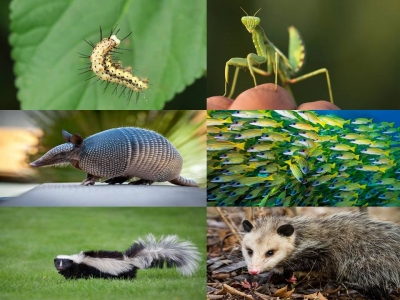
Survival in the animal kingdom is not easy. With predators a constant threat, animals have adopted all kinds of different defences to protect themselves. For some, the best form of defence is attack. These animals bite or kick, or rely on poison. Others choose to lie low, hiding from danger or playing dead.
Spikes
Postman caterpillar
Heliconius Melpomene, the postman butterfly, common postman or simply postman, is a brightly colored butterfly found throughout Mexico and Central America. H. Melpomene was one of the first butterfly species observed to forage for pollen, a behavior that is common in other groups but rare in butterflies. H. Melpomene possesses ultraviolet vision which enhances its ability to distinguish subtle differences between markings on the wings of other butterflies. Small animals may try to look fierce to avoid being eaten. Some caterpillars grow large spikes to make them difficult to eat. Postman caterpillars also keep the poison from the plants they eat to make themselves poisonous as well.
Startle
Praying mantis
The praying mantis is named for its prominent front legs, which are bent and held together at an angle that suggests the position of prayer. By any name, these fascinating insects are formidable predators. They have triangular heads poised on a long “neck,” or elongated thorax. Mantis can turn their heads 180 degrees to scan their surroundings with two large compound eyes and three other simple eyes located between them. This praying mantis uses a combination of defences. Usually, it is hard to spot because it looks like a dried-up leaf. However, if a predator gets too close, the dead leaf mantis opens up its arms and wings, flashing bright colours that surprise the attacker and scare it away.
Play dead
Opossum
Opossums are scavengers, and they often visit human homes or settlements to raid garbage cans, dumpsters, and other containers. They are attracted to carrion and can often be spotted near roadkill. Opossums also eat grass, nuts, and fruit. They will hunt mice, birds, insects, worms, snakes, and even chickens. Some animals fake their own deaths to avoid being eaten. If a Virginia opossum sees a predator, it curls up and stops moving. This state can last for hours, making it look like it is dead. It even releases a rotting smell, so predator leave it alone and search for fresh prey instead.
Armour
Armadillo
Armadillos live in temperate and warm habitats, including rain forests, grasslands, and semi-deserts. Because of their low metabolic rate and lack of fat stores, cold is their enemy and spates of intemperate weather can wipe out whole populations. For slow-moving animals, body armour can be a life-saver. A hard shell or tough skin can be a real challenge for a predator. The three-banded armadillo is covered in overlapping bony plates. When it rolls into a ball there is no way for a hungry hunter to get to its head or soft belly.
Smell
Skunk
Skunks are nocturnal, which means they search for food at night and sleep in dens lined with leaves during the day. Their favorite foods include fruit and plants, plus insects, bird eggs, small rodents, and birds. Birds like the great horned owl prey on skunks. Scientists believe it’s because the birds don’t have a very good sense of smell, which makes the skunk’s spray useless in an attack. Bad smells can keep predators away, especially when the whiff is like rotten eggs! Skunks are too slow to escape at speed, so they spray a foul-smiling liquid from their rear end. This eye-watering scent is so powerful it can be detected 1.6 km (1 mile) away.
Shoal
Snappers
Snappers are found, often in abundance, throughout the tropics. Active, schooling fishes with elongated bodies, large mouths, sharp canine teeth, and blunt or forked tails, snappers are usually rather large, many attaining a length of 60–90 centimetres (2–3 feet). They are carnivores and prey on crustaceans and other fishes. A small fish travelling alone is an easy target for predators. Many fish species, such as these black spot snappers, stick together in shoals of hundreds. Each individual fish gets lost in the crowd, so it is much harder for a victim to be singled out by a predator.
Picture Credit : Google
